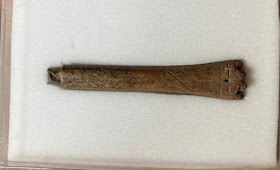Animal bones found at archaeological excavations can provide valuable information about the past. They can tell us about butchery and eating habits, tool use, and the environment the bones were disposed of or buried in.
First, we must identify
which animal the bones belong to. We can look at the overall size and
robusticity of the bones, as well as the cranium (skull) and the mandible (jaw).
The size, curvature, and profile of the mandible display distinct differences
between animals. Sheep mandibles flare at the curve of the jaw, which differs
from the more sloping profile of pig mandibles.
Pigs have one of the most distinctive teeth of domestic mammals. As omnivores, their teeth need to be able to both slice and grind their food, and so they display more pronounced canines and incisors compared to herbivores. Their teeth have flat shaped cusps ideal for their diet, this contrasts with the “W” shaped profile of sheep teeth, deer and cattle.
 |
| Sheep mandible (left), pig mandible (right) |
Once the bone has been identified, we can examine the texture for signs of use by humans. Looking at the long bones for marks and scrapes can indicate intentional defleshing and butchery.
Differences in butchery methods and skill can lead to differences in cut marks, and it can sometimes be difficult to identify signs of intentional butchery. The clearest way to do so is by observing a V-shaped cross section. This V shape is characteristic of cutting with a lithic or metal knife, whereas a U-shaped mark indicates stone tools were used.
 |
| Sheep tibia with cut marks (left), split cow radius (right) |
Worked bone is also common, and indicates bone was also used to make tools, decorations and jewellery. Bone can be polished and incised with a decorative pattern.
 |
| This worked Roman sheep metapodia that was used as a handle for a blade or utensil |
The colour and condition of the
bones can also reveal information about the environment the remains were
discarded or buried in, as well as actions of other animals.
When bones are discarded there is
often still meat on the bone, and this can attract rodents which leave distinct
parallel grooves and scrapes.
A bright white bone indicates it
was bleached by sunlight, whereas black and dark brown suggest exposure to
bacteria, fungi and soil minerals. Green marks indicate contact with copper; this
is a frequent occurrence in human remains due to grave goods. By noting these observations,
we can construct a profile of the animal's environment.
Overall, there is much to be
learned from animal bones in the archaeological context!
Lauren
Collections placement student
No comments:
Post a Comment